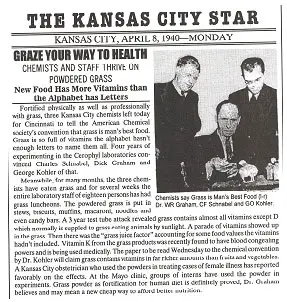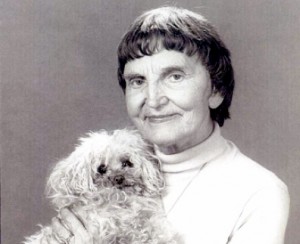Wheatgrass has a long history of incredibly safe, and incredibly effective use.
Over time, the benefits of this miracle grass have long been forgotten, however.
The first use of wheatgrass can be traced back to about 5,000 years ago when the ancient Egyptians used young grass for health and vitality. In modern times, wheatgrass consumption was introduced to the Western world by a Food Chemist from Kansas City, Missouri Charles Franklin Schnabel, who is often called “the Father of Wheatgrass.” And later it became popular because of Dr. Ann Wigmore, who Founded the Hippocrates Health Institute.
Charles Franklin Schnabel: The Father of Wheatgrass
 In 1928, when the idea of vitamins in nutrition was only starting to achieve recognition among health scientists, Schnabel was searching for a “blood-building material” to help heal chickens – to decrease their mortality while increasing their egg production, according to the book Cereal Grass: What’s in it for you! by Ronald L. Seibold, M.S (written in 1990 for PINES International, Inc.).
In 1928, when the idea of vitamins in nutrition was only starting to achieve recognition among health scientists, Schnabel was searching for a “blood-building material” to help heal chickens – to decrease their mortality while increasing their egg production, according to the book Cereal Grass: What’s in it for you! by Ronald L. Seibold, M.S (written in 1990 for PINES International, Inc.).
Schnabel knew that chlorophyll was structurally similar to hemoglobin, therefore his reasoning was that “green leaves should be the best source of blood.”
He experimented with different vegetables and greens but nothing produced the effect he was looking for until he came across “immature wheat.” Substituting just 10% of chickens’ diet with it increased egg production in winter from 38% to 94%. The eggs also had stronger shells.
He could not yet explain scientifically why it happened, but stated that the results were so easily observed that “even a child can see the bloom of health in the grass-fed hens,” according to Seibold’s book. Schnabel then spent years studying nutrition of the grasses.
Schnabel started making powdered dry grass and giving it to his family of 7 and his neighbors as a dietary supplement. In 1942 Buffalo Courier Express reported that Schnabel fed his family wheatgrass for 11 years and none of his children were reported to have ever had any health problems or even a tooth cavity.
 In 1940s Schnabel spread the word of his findings of wheatgrass health benefits to feed mills and the food industry. Two big companies stepped forward, Quaker Oats and American Diaries, Inc., and invested millions of dollars into further research, according to Illinois State University.
In 1940s Schnabel spread the word of his findings of wheatgrass health benefits to feed mills and the food industry. Two big companies stepped forward, Quaker Oats and American Diaries, Inc., and invested millions of dollars into further research, according to Illinois State University.
That same year a can of Schabel’s powdered grass could be bought in major drug stores across the U.S. and Canada under Cerophyl Laboratories, Inc., jointly owned by Quaker Oats and American Diaries. In 1942 Schnabel’s discovery about the nutritional value of wheatgrass earned him an honorary degree from Rockhurst College.
Unfortunately by the end of World War II, people became more interested in materialistic products and less in personal nutrition, so Schnabel’s success was very short-lived, wrote health advocate Steve Meyerowitz in the book Wheatgrass: Nature’s Finest Medicine: The Complete Guide to Using Grass Foods & Juices to Revitalize Your Health.
What also created a big obstacle was the growing pharmaceutical industry. The industry became a big player and marketed pesticide-sprayed crops as “better living through chemistry” and synthetic nutrients as multi-vitamins, according to Kansas City’s Architectural & Historical Research.
People became more and more disinterested in food-based supplement, and the research on wheatgrass was quickly forgotten.
***
Click Here to Buy Organic Superfood Bars, Packed With Green Superfoods
(On Sale Now, Try Them Here (Red Velvet and Lemon Meringue are My Favorite)
***
According to Meyerowitz, at the peak of Schnabel’s career his goal included four ways in which wheatgrass could change society for the better. First, the soil would be enriched again. Secondly, farmers would be more prosperous by growing nutritional grass instead of other crops. Thirdly, a new industry would be created in order to process, dehydrate, package and distribute the wheatgrass. And finally, consumers would receive great health benefits from a low-cost vitamin and trace mineral-rich supplement. His dreams got challenged by the post-war and post-depression era, so his four-step plan never got a chance to be realized.
Years later, in 1960-1970s it was Wigmore who made drinking wheatgrass juice actually popular.
Ann Wigmore’s Legacy
In 1940s Wigmore healed herself of cancer with weeds she collected herself around Boston, according to Seibold. That motivated her to study natural healing modalities and together with a friend of hers, Dr. Earp Thomas; she found out that there are 4,700 types of edible grass in the world, but wheatgrass is the best for medicinal qualities. She started juicing the wheatgrass and delivering it to the ill people around her neighborhood in Boston, according to Meyerowitz.
In 1961 she officially opened the doors of the Hippocrates Health Institute with the message that the body can heal itself with assistance from natural sources. Soon she had many positive testimonials from her guests who had success with wheatgrass helping them with variety of illnesses: from high blood pressure and diabetes to fatigue and anemia. She unsuccessfully tried to teach the U.S. government about the potential of wheatgrass in curing illnesses, and had more success abroad. She kept spreading her message about health until her death in 1994.
Today many grow wheatgrass in their own homes; it is being offered in juice form in many health-oriented cafes, alternative health clinics recommend it for detoxification and general health, and it is still sold as a supplement, by companies such as PINES International, Inc. There have been a few studies done, and there are hundreds of personal testimonials praising wheatgrass, which is now regarded as one of the absolute best nutritional supplements on the market, especially when grown locally and served fresh.
Thanks for installing the Bottom of every post plugin by Corey Salzano. Contact me if you need custom WordPress plugins or website design.







